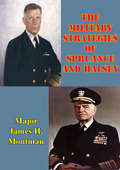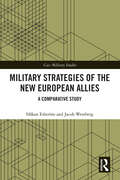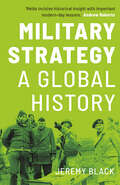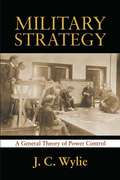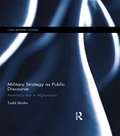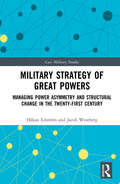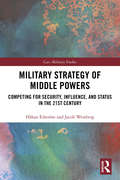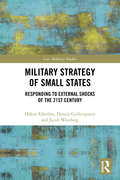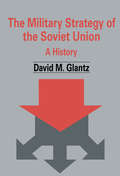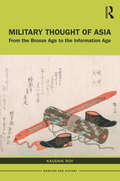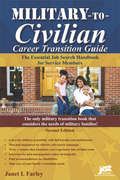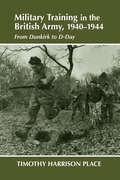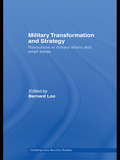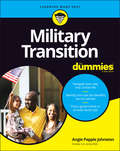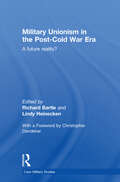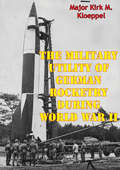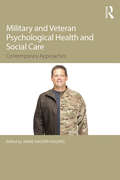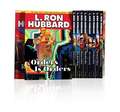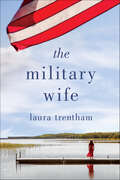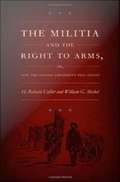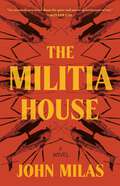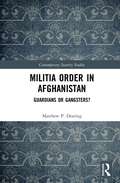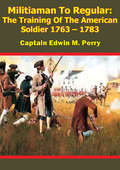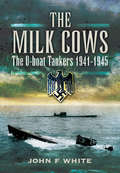- Table View
- List View
The Military Strategies Of Spruance And Halsey
by Major James H. MontmanThe military strategy utilized by two great World War Two U.S. Navy leaders will provide an insight into the evolution of the strategy process. This paper will examine two Pacific Theater leaders involved in the early employment of a relatively new naval weapon system, the aircraft carrier. Carrier air power was virtually untested at the beginning of the second world war and eventually developed into a most formidable battle tool. The Battle of Coral Sea provided a basis for carrier tactics employed in later engagements such as the Battle of Midway. The military strategy of Admiral Raymond A. Spruance will be examined with respect to the Battle of Midway. Midway was the first major decisive naval battle where the outcome was decided on the basis of aircraft carrier operations alone. The battle was fought against a numerically superior force during the period that the Japanese Navy was strongly on the offensive.Next, the military strategy of Admiral William F. Halsey as utilized during the Battle for Leyte Gulf will be reviewed with a continuing focus on carrier air power. Leyte Gulf was a complex group of four battles involving carrier air as well as land based air power, surface engagements and invasion forces. The battle was fought against a Japanese on force with relatively few remaining carrier air resources. Also, it was fought from an American offensive position, as U.S. forces pressed toward Japan through the Philippines.Finally, an analysis of the strategy used by these two great warriors will be made within the context of the ACSC strategy process model in an effort to increase the understanding of the process of strategy and its derivation. A brief look at selected principles of war is also included in an effort to correlate abstract thought strategy and the conduct of war with actual warfighting experiences.
Military Strategies of the New European Allies: A Comparative Study (Cass Military Studies)
by Håkan Edström Jacob WestbergThis book analyses how and to what extent ex-communist states have adjusted their defence strategies since joining the EU and NATO, and how differences and similarities between their strategies can be explained. Between 1999 and 2013, four phases of enlargement took place when the European Union (EU) and NATO allowed 11 new former communist states to enter both organisations. These states share some common attributes and experiences related to strategic culture and common experiences during the Cold War era that can potentially explain similarities in behaviour and preferences among them. However, the strategic adjustments among these states are far from uniform. In an effort to explain these differences, the book introduces three intervening variables: (1) differences in relative power and position in the international system, (2) national geographical characteristics; and (3) historical experiences related to formative periods of state-building processes as well as wars and armed conflicts. Empirically, the book strives to present and analyse the defence strategies of each of the new allies by conducting a structured focused comparison of official strategic documents from the twenty-first century for each of the 11 cases. Theoretically and methodologically, it introduces an analytical framework enabling us to explain both similarities and differences in the formulation of the strategies of the 11 states, and to shed light on their external and internal efforts to promote their strategic interest by operationalising the dependent variable - defence strategy. The analytical framework combines elements of structural realism with classical realism, and constructivist research on unit-level characteristics related to relative power and perceptions of strategic exposure. This book will be of much interest to students of strategic studies, European Union policy, NATO and International Relations in general.
Military Strategy: A Global History
by Jeremy BlackA global account of military strategy, which examines the practices, rather than the theories, of the most significant military figures of the past 400 years Strategy has existed as long as there has been organised conflict. In this new account, Jeremy Black explores the ever-changing relationship between purpose, force, implementation and effectiveness in military strategy and its dramatic impact on the development of the global power system. Taking a &‘total&’ view of strategy, Black looks at leading powers — notably the United States, China, Britain and Russia — in the wider context of their competition and their domestic and international strengths. Ranging from France&’s Ancien Regime and Britain&’s empire building to present day conflicts in the Middle East, Black devotes particular attention to the strategic practice and decisions of the Kangxi Emperor, Clausewitz, Napoleon and Hitler.
Military Strategy
by Joseph Caldwell Wylie Jr"No military service can long remain effective without searching self-criticism and continuous re-examination of its own ideas. Wylie, well known in the Navy, is a refreshingly and outspoken individual, thoroughly at home on the bridge of a ship, but equally at home in the semantics of dialectical discussion. He has produced a simple but relevant little work in an attempt to promote order in the discussion of strategy. . . . To the traditional theories of strategy-the maritime theory, the air theory, the continental theory-Wylie adds the 'Mao theory' of wars of national liberation. . . . [This book is] easier to read and understand and basically sounder than the great majority of the involved and tortuous rationalizations of the academic strategists."- New York Times Book Review
Military Strategy as Public Discourse: America's war in Afghanistan (Cass Military Studies)
by Tadd SholtisThis book presents the current history of United States military strategy in Afghanistan as an example of dysfunctional policy discourse among the nation’s elites. The legitimacy of a country’s military strategy can become a subject of intense public debate and doubt, especially in prolonged conflicts. Arguments typically hinge on disagreements about the values at stake, the consequences of action or inaction, and the authority of those responsible for the plan. As the US entered its second decade at war in Afghanistan, political and military leaders struggled to explain the ends and means of their strategy through internal policy debates, the promotion of counterinsurgency doctrine, and day-to-day accounts of the war’s progress. Military Strategy as Public Discourse considers recent US strategy in Afghanistan as a form of valid and equitable public discussion among those with the ability to affect outcomes. The work examines the dominant forms of discourse used by the various groups of elites who make and execute strategy, and considers how representations of these forms of discourse in news media shapes elite understanding of the purpose of US efforts in wars of choice. The book proposes how policy-makers should address the problems of public discourse on war, which tends to exclude or marginalize relevant elites and focus on narrow questions of validity. This book will be of much interest to students of strategic studies, US foreign policy, and security studies in general.
Military Strategy of Great Powers: Managing Power Asymmetry and Structural Change in the 21st Century (Cass Military Studies)
by Håkan Edström Jacob WestbergThis book explores the military strategies of the five system-determining great powers during the twenty-first century. The book’s point of departure is that analyses of countries’ defence strategies should acknowledge that states come in various shapes and sizes and that their strategic choices are affected by their perceptions of their position in the international system and by power asymmetries between more and less resourceful states. This creates a diversity in strategies that is often overlooked in theoretically oriented analyses. The book examines how five major powers – the United States, China, the United Kingdom, France and Russia – have adjusted their strategies to improve or maintain their relative position and to manage power asymmetries during the twenty-first century. It also develops and applies an analytical framework for exploring and categorising the strategies pursued by the five major powers which combines elements of structural realism with research on power transition theory and status competition. The concluding chapter addresses questions related to stability and change in the present international system. This book will be of interest to students of strategic studies, foreign policy, and International Relations.
Military Strategy of Middle Powers: Competing for Security, Influence, and Status in the 21st Century (Cass Military Studies)
by Håkan Edström Jacob WestbergMilitary Strategy of Middle Powers explores to what degree twenty-first-century middle powers adjust their military strategies due to changes in the international order, such as the decline in US power. The overarching objective of the book is to explain continuity and change in the strategies of a group of middle powers during the twenty-first century. These strategies are described, compared, and explained through the lens of Realism. In order to find potential explanations for change or continuity within the cases, as well as for similarities and differences between the cases, the strategies of 11 ‘middle’ powers are analysed (Canada, Germany, Italy, Spain, Australia, Brazil, Indonesia, South Africa, India, Japan, and South Korea). This group of countries are considered similar in several important aspects, primarily regarding relative power capacity. When searching for potential explanations for different strategic behaviours among the middle powers, their unique regional characteristics are a key focus and, consequently, the impact of the structure and polarity, as well as the patterns of amity and enmity, of the regional context are analysed. The empirical investigation is focused on security strategies used since the terrorist attacks 9/11 2001, which was one of the first major challenges to US hegemony. This book will be of much interest to students of military and strategic studies, foreign policy, and International Relations in general.
Military Strategy of Small States: Responding to External Shocks of the 21st Century (Cass Military Studies)
by Håkan Edström Dennis Gyllensporre Jacob WestbergThe book explores how small states adjust their military strategies in response to external shocks. Using primary sources from four Nordic countries, (Denmark, Finland, Norway, and Sweden), this volume explores how small states have adjusted their military strategies in response to external shocks of the 21st century. The 9/11 terrorist attacks, the Russian interventions in Georgia and Ukraine, and the rise of the Islamic State have all forced the Nordic states to adopt new strategies. While the responses have not been uniform, their differing relations to the EU and NATO have not prevented these countries from behaving similarly in military affairs. Limitations in military capacity has led all four countries to pursue strategies that include cooperation with more resourceful partners. It is necessary for them to cooperate with others to protect and promote their national interests. Moreover, the Nordic cosmopolitan outlook expresses milieu-shaping ambitions that we generally would not expect small states to pursue against a potential great power aggressor. This book will be of much interest to students of military strategy, defense studies, security studies, and international relations.
The Military Strategy of the Soviet Union: A History (Soviet (Russian) Military Theory and Practice #No. 6)
by David M. GlantzArmed revolution and civil war gave birth to the Soviet Union, world War II propelled it to global pre-eminence, and the Cold War contributed to the Soviet Union's demise. Given Marxism-Leninism's idological preoccupation with war and threats of war, it is understandable that the spectre of war should play a vital role in the life and fate of the Soviet state.This study of Soviet military strategy is based upon the twin pillars of Soviet political-military actions and Soviet writings on the subject of military strategy. Thanks to the policy of glasnost, it incorporates Soviet materials hitherto unavailable in the West. It aims to be not simply a retrospective account of what was, but to form part of the context for what will be in the future.
Military Thought of Asia: From the Bronze Age to the Information Age (Warfare and History)
by Kaushik RoyMilitary Thought of Asia challenges the assertion that the generation of rational secular ideas about the conduct of warfare is the preserve of the West, by analysing the history of ideas of warfare in Asia from the ancient period to the present. The volume takes a transcontinental and comparative approach to provide a broad overview of the evolution of military thought in Asia. The military traditions and theories which have emerged in different parts of Eurasia throughout history are products of geopolitics and unique to the different regions. The book considers the systematic and tight representation of ideas by famous figures including Kautlya and Sun Tzu. At the same time, it also highlights publications on military affairs by small men like mid-ranking officers and scattered ideas regarding the origin, nature and societal impact of organised violence present in miscellaneous sources like coins, inscriptions, paintings and fictional literature. In so doing, the book fills a historiographical gap in scholarship on military thought, which marginalises Asia to the part of cameo, and historicises the evolution of theory and the praxis of warfare. The volume shows that the ‘East’ has a long unbroken tradition of conceptualising war and its place in society from the Classical Era to the Information Age. It is essential reading for those interested in the evolution of military thought throughout history, particularly in Asia.
Military-to-Civilian Career Transition Guide: The Essential Job Search Handbook for Service Members (Second Edition)
by Janet I. FarleyThis handbook provides a career transition framework for service members and their families. Readers are given exit strategies for gracefully leaving the military; charts, checklists, and worksheets for planning each transition aspect; resume and cover letter samples and strategies; and interviewing and salary negotiation tips.
Military Training in the British Army, 1940-1944: From Dunkirk to D-Day (Military History and Policy #No. 6)
by Dr Timothy Place Timothy Harrison PlaceIn this study, the author traces the reasons for the British Army's tactical weakness in Normany to flaws in its training in Britain. The armour suffered from failures of experience. Disagreements between General Montgomery and the War Office exacerbated matters.
Military Transformation and Strategy: Revolutions in Military Affairs and Small States (Contemporary Security Studies)
by Bernard LooThis book explores the idea of arevolution in military affairs (RMA), which underpins the transformational agenda of the US military, and examines its implications for smaller states.The strategic studies literature on the RMA tends to be American-centric and directed towards the strategic problems of the US military. This volume seeks to fill t
Military Transition For Dummies
by Angie Papple JohnstonConquer civilian life after the serviceYou’ve served your country proudly. Now it’s time to discover all the things your country can do for you! In Military Transition For Dummies, you’ll learn how to tackle civilian life from a tactical standpoint, head on and full bore. Find out how to set yourself up for success before you leave the service and what to do when you land in the civilian world. Whether your sights are set on re-entering the workforce or you’re aiming to go back to school, this book walks you through each step of the way.Inside…Prepare for your separationFind your place as a civilianAccess veteran resourcesPerfect your resumeConquer job interviewsFind a great job or schoolManage your money wiselyGet the support you need
Military Unionism In The Post-Cold War Era: A Future Reality? (Cass Military Studies)
by Lindy Heinecken Richard BartleThis unique study of military unionism shows how the changing nature of present day conflicts has made soldier representation more important then ever. This new collection of essays clearly establish the key factors in the military union debate in recent years and highlight the mechanisms different armed forces have created to deal with the aspirations of their members. Core issues covered include: the nature of organizational and force restructuring since the end of the Cold War the new structures of military employment changes in value systems, such as rising individualism and the new culture of recruits legal, political, social and economic factors driving the debate. Placing military unionism in comparative perspective, these chapters provide the reader with an excellent basis for the examination of international military unionism from the viewpoint of countries with no unions, those recently unionised and those unionised for some time. This new book will be of great interest to students, researchers and professionals in military studies, defence management and sociology of the armed forces.
The Military Utility Of German Rocketry During World War II
by Major Kirk M. KloeppelThe Tomahawk cruise missile, the conventional Air Launched Cruise missile, and the SCUD surface-to-surface missile each made an impact during the Gulf War. The cruise missiles were instrumental in incapacitating the Iraqi electrical network. The SCUD missile was not as successful, but did divert the coalition air campaign. Although never utilized, the sister of the SCUD missile, the intercontinental ballistic missile, was pivotal during the Cold War. Each of these weapons can trace their initiation to the development of the German V-1 flying bomb and V-2 rocket during World War II.The German weapons were not as successful as their antecedents. This paper will inspect the military utility of the weapons during World War II. Initially, the paper will define the actors behind the development, and describe the resulting weapons. Next, the essay will examine the strategy in weapon utilization. The paper will quantify the damage caused by both weapons. Then, the document will describe offensive and defensive countermeasures employed by the Allies. The question of the weapons' military utility will be addressed. Finally, alternatives to the weapons development, production, and employment will be presented.
Military Veteran Psychological Health and Social Care: Contemporary Issues
by Jamie Hacker HughesWhen servicewomen and men leave the armed forces, their care transfers to the statutory and third sector where the quality and provision of services can vary enormously. This edited book, encompassing a range of perspectives, from service user to professional, provides a comprehensive overview of services available. Each chapter, in turn, examines the policy underpinnings of systems and services covering the psychological health and social care of military veterans and then focuses on the needs of a discrete number of types of military veterans including early service leavers, veterans in the criminal justice system, older veterans and reservists, together with the needs of the children of veterans’ families. This is the first UK book to examine the whole spectrum of contemporary approaches to the psychological health and social care of military veterans both in the United Kingdom and overseas. The book is edited by Professor Jamie Hacker Hughes, a former head of healthcare psychology within the UK Ministry of Defence and all contributors are experts in policy, service provision and academic research in this area. It will be of special interest to those designing and planning, commissioning, managing and delivering mental health and social care to military veterans and their families
Military & War Collection, The
by L. Ron HubbardTriumphant tales of heroes, honor and impossible odds. Launch into the action with these gripping and gritty tales that appeared in the pages of the most popular pulp fiction magazines of the 1930's and 1940's. "It's certainly loads of fun." --Ellery QueenThis Collection includes: International Book Awards Winner: On Blazing Wings, International Book Awards Finalists: The Phantom Patrol & Hostage to Death as well as Orders is Orders, While Bugles Blow!, Sabotage in the Sky, Wind-Gone-Mad, The Falcon Killer, Hell's Legionnaire and Red Death Over China.
The Military Wife: A Heart Of A Hero Novel (Heart Of A Hero Ser. #1)
by Laura TrenthamA young widow embraces a second chance at life when she reconnects with those who understand the sacrifices made by American soldiers and their families in award-winning author Laura Trentham’s The Military Wife.Harper Lee Wilcox has been marking time in her hometown of Kitty Hawk, North Carolina since her husband, Noah Wilcox’s death, nearly five years earlier. With her son Ben turning five and living at home with her mother, Harper fights a growing restlessness, worried that moving on means leaving the memory of her husband behind.Her best friend, Allison Teague, is dealing with struggles of her own. Her husband, a former SEAL that served with Noah, was injured while deployed and has come home physically healed but fighting PTSD. With three children underfoot and unable to help her husband, Allison is at her wit’s end.In an effort to reenergize her own life, Harper sees an opportunity to help not only Allison but a network of other military wives eager to support her idea of starting a string of coffee houses close to military bases around the country.In her pursuit of her dream, Harper crosses paths with Bennett Caldwell, Noah’s best friend and SEAL brother. A man who has a promise to keep, entangling their lives in ways neither of them can foresee. As her business grows so does an unexpected relationship with Bennett. Can Harper let go of her grief and build a future with Bennett even as the man they both loved haunts their pasts?
The Military’s Business
by Mikkel Vedby RasmussenIf the military were a business, would you buy shares? Over recent years, Western armed forces, particularly the US, have been costing more yet achieving less. At the same time, austerity measures are reducing defence budgets. This book uses defence data to examine the workings of modern Western militaries and explore what kind of strategies can overcome this gap between input and output. Instead of focusing on military strategy, Mikkel Vedby Rasmussen seeks to draw on the ideas of business strategy to assess alternative business cases - reforming military HR to combat instability in the 'Global South' or utilising new technologies to overcome the prohibitive costs of current systems. Analysing the philosophical, strategic and budgetary underpinnings of these alternatives, he concludes that a more radical break from current military organisational practices is needed which would allow them to fit within a nation's overall national security system without ever-increasing budgets.
The Militia and the Right to Arms, or, How the Second Amendment Fell Silent
by H. Richard Uviller William G. Merkel"A well regulated Militia, being necessary to the security of a free State, the right of the people to keep and bear Arms, shall not be infringed. " --Amendment II, United States Constitution The Second Amendment is regularly invoked by opponents of gun control, but H. Richard Uviller and William G. Merkel argue the amendment has nothing to contribute to debates over private access to firearms. In The Militia and the Right to Arms, or, How the Second Amendment Fell Silent, Uviller and Merkel show how postratification history has sapped the Second Amendment of its meaning. Starting with a detailed examination of the political principles of the founders, the authors build the case that the amendment's second clause (declaring the right to bear arms) depends entirely on the premise set out in the amendment's first clause (stating that a well-regulated militia is necessary to the security of a free state). The authors demonstrate that the militia envisioned by the framers of the Bill of Rights in 1789 has long since disappeared from the American scene, leaving no lineal descendants. The constitutional right to bear arms, Uviller and Merkel conclude, has evaporated along with the universal militia of the eighteenth century. Using records from the founding era, Uviller and Merkel explain that the Second Amendment was motivated by a deep fear of standing armies. To guard against the debilitating effects of militarism, and against the ultimate danger of a would-be Caesar at the head of a great professional army, the founders sought to guarantee the existence of well-trained, self-armed, locally commanded citizen militia, in which service was compulsory. By its very existence, this militia would obviate the need for a large and dangerous regular army. But as Uviller and Merkel describe the gradual rise of the United States Army and the National Guard over the last two hundred years, they highlight the nation's abandonment of the militia ideal so dear to the framers. The authors discuss issues of constitutional interpretation in light of radically changed social circumstances and contrast their position with the arguments of a diverse group of constitutional scholars including Sanford Levinson, Carl Bogus, William Van Alstyne, and Akhil Reed Amar. Espousing a centrist position in the polarized arena of Second Amendment interpretation, this book will appeal to those wanting to know more about the amendment's relevance to the issue of gun control, as well as to those interested in the constitutional and political context of America's military history.
The Militia House: A Novel
by John MilasLonglisted for the Center for Fiction's First Novel PrizeNominated for the 2023 Shirley Jackson Award“An extraordinary novel about the quiet and not so quiet horrors of war.” —Roxane GayStephen King meets Tim O’Brien in John Milas’s The Militia House, a spine-tingling and boldly original gothic horror novel.It’s 2010, and the recently promoted Corporal Loyette and his unit are finishing up their deployment at a new base in Kajaki, Afghanistan. Their duties here are straightforward—loading and unloading cargo into and out of helicopters—and their days are a mix of boredom and dread. The Brits they’re replacing delight in telling them the history of the old barracks just off base, a Soviet-era militia house they claim is haunted, and Loyette and his men don’t need much convincing to make a clandestine trip outside the wire to explore it. It’s a short, middle-of-the-day adventure, but the men experience a mounting agitation after their visit to the militia house. In the days that follow they try to forget about the strange, unsettling sights and sounds from the house, but things are increasingly . . . not right. Loyette becomes determined to ignore his and his marines’ growing unease, convinced that it’s just the strain of war playing tricks on them. But something about the militia house will not let them go.Meticulously plotted and viscerally immediate in its telling, The Militia House is a gripping and brilliant exploration of the unceasing horrors of war that’s no more easily shaken than the militia house itself.
Militia Order in Afghanistan: Guardians or Gangsters? (Contemporary Security Studies)
by Matthew P. DearingThis book offers a new insight into when and why paramilitary groups in Afghanistan engage in protective or predatory behavior against the civilians they purportedly defend. In Afghanistan’s counterinsurgency environment, America leaned on militias to provide order and stabilize communities cut off from weak central government institutions. However, the lucrative market of protection challenged militia loyalty, as many engaged in banditry, vendettas, and predation. This book examines the varying militia experiments in Afghanistan from 2001 to 2020 and their outcomes through three sub-national case studies. It argues that successful militia experiments in Afghanistan involved inclusion of local orders, where communities had well-established social structures and accountability mechanisms in place, and state patrons relied upon those structures as a restraint against militia behavior. Complementary management ensured patrons leaned on communities for strong accountability systems. But such environments were far from the norm. When patrons ignored community controls, militias preyed on civilians as they monopolized the market of protection. This book adds to the rich literature on the U.S. experience in Afghanistan, but differs by focusing on the interplay between states, communities, and militias. This book will be of much interest to students of military and strategic studies, Asian politics, security studies and International Relations.
Militiaman To Regular: The Training Of The American Soldier 1763 – 1783
by Captain Edwin M. PerryThe militiaman of 1775 evolved into the regular soldier of 1783 because Americans changed their perception as to what constituted military preparedness. Political pamphlets and religious sermons had readied the colonists emotionally and intellectually to take up arms against the British. But their militia's training which stressed musket drill was inadequate and prepared them only for battle. During 1776 and 1777 Washington attempted to correct the soldiers' deficiencies and used his General Orders to train the Continental Army for war. After 1778 Washington was assisted by Steuben, who as the army's Inspector General stressed uniformity in drill and maneuver, as well as emphasizing the maintenance of equipment. Steuben's and Washington's efforts transformed the soldiers of the Continental Army into competent professionals who were able to engage successfully their European counterparts in battle while sustaining themselves in a war.
The Milk Cows: The U-Boat Tankers, 1941–1945
by John F. White&“A comprehensive look at the German submarine tanker program during World War II . . . engaging.&” —The NYMAS Review During the Second World War the Germans developed a specially adapted U-boat oil tanker with two aims. First, by refueling the attack U-boat fleet their range of operations and duration of patrol could be significantly increased. Secondly, these underwater tankers were far more likely to avoid detection than surface support ships. The submarine tankers, affectionately known as &“Milk Cows,&” were regarded by both the Germans and the Allies as the most important element of the U-boat fleet. Allied forces had orders to attack the tankers first whenever a choice was presented. Until late 1942 the German Milk Cows operated with great success and few losses. But from 1943 onwards the German rendezvous ciphers were repeatedly broken by the Allies and losses mounted rapidly. The Milk Cows were highly vulnerable during the lengthy refueling procedure as they lay stationary on the surface, hatches open. By the end of the war virtually every tanker had been sunk with severe loss of life. The story of this critical campaign has been thoroughly researched by the author and is told against the background of changing U-boat fortunes.&“The author is to be congratulated on his research and writing such a thorough and readable account of such an interesting subject.&” —Windscreen Magazine, Military Vehicles Trust&“Readers will be fascinated not just by the mainstream replenishment work but also by the book&’s accounts of German submarine operations far afield.&” —Navy News
